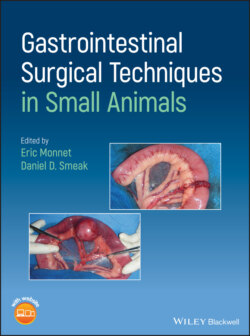Читать книгу Gastrointestinal Surgical Techniques in Small Animals - Группа авторов - Страница 14
1.1 Anatomy
ОглавлениеThe wall of the gastrointestinal tract has a mucosa, a submucosa, a muscularis, and a serosa, except the esophagus and the distal rectum.
The mucosa has three distinct layers: the epithelium, the lamina propria and the muscularis mucosa. The lamina propria layer is made of vessels, lymphatics, and mesenchymal cells whereas the muscularis mucosa is a thin muscle layer. After completing the anastomosis, the mucosa heals very fast by epithelial cells migration over the defect providing a rapid barrier from the intestinal content. For intestinal healing to occur, a good surgical apposition of layers is required; everting or inverting patterns interfere with mucosal healing.
The submucosa layer, incorporating the bulk of the collagen, is the holding layer in intestinal surgery. Type I collagen (68%) predominates in the submucosa, followed by type III (20%) and finally collagen type V (12%) (Thornton and Barbul 1997). It is a loose connective tissue with lymphatic, nerve fibers, ganglia, and blood vessels that should be preserved during surgery. The muscularis layer consists of an inner circular muscle layer, a longitudinal outer muscle layer and collagen fibers. The serosal surface is made of connective tissue with mesothelial cells, lymphatics, and blood vessels. The serosa is important in the healing process because it helps prevent leakage of the gastrointestinal content in the immediate post‐operative period.
